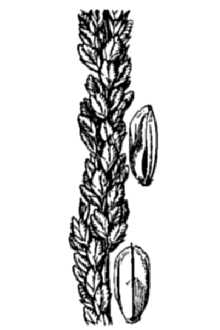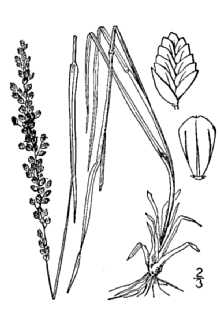Rhombolytrum albescens (Vasey) Nash
Scientific Name: Rhombolytrum albescens (Vasey) Nash

| General Information | |
|---|---|
| Usda Symbol | RHAL7 |
| Group | Monocot |
| Life Cycle | Perennial |
| Growth Habits | Graminoid |
| Native Locations | RHAL7 |
Plant Guide
Description
General: White tridens is a warm season perennial grass with short-knotty, hard rhizomatous bases. Culms average 15 to 40 inches (40-100 cm) tall with 6 to 12 inch (15-30 cm) long blades that are flat, glabrous, with blue-green color. The inflorescence is a dense panicle, 8 inches long (20 cm) with appressed branches. Spikelets are white to pinkish purple-tinged (Blackworth et al., 2007 and Shaw, 2012). Caryopses are pale yellow to white. White tridens averages 4,535,900 seeds per pound. Distribution: White tridens occurs in Texas, Oklahoma, and New Mexico west of US highway 45, and extending south into Mexico. It is found primarily on clay or loamy soils that periodically receive an abundance of water (Powell, 1994 and Everitt et al., 2011). For current distribution, please consult the Plant Profile page for this species on the PLANTS Web site. Habitat: White tridens is usually associated with buffalograss [Bouteloua dactyloides (Nutt.) J.T. Columbus] and bristlegrass [Setaria vulpiseta (Lam.) Roemer & J.A. Schultes]. It is commonly found in partial shade, wet areas, ditches, or swales (Hatch et. Al., 1999).
Adaptation
White tridens is adapted to low prairies, ditches, swales, and open woods on clay and loam soils prone to inundation.
Uses
White tridens can be used for critical area revegetation, erosion control, right-of-way plantings, inclusion in range mixes for forage and wildlife plantings. White tridens may also have value for riparian and wetland plantings.
Status
This plant may become weedy or invasive in some regions or habitats and may displace desirable vegetation if not properly managed. Please consult with your local NRCS Field Office, Cooperative Extension Service office, state natural resource, or state agriculture department regarding its status and use. Please consult the PLANTS Web site (http://plants.usda.gov/) and your state’s Department of Natural Resources for this plant’s current status (e.g., threatened or endangered species, state noxious status, and wetland indicator values).
Planting Guidelines
Seedbed preparation should begin well in advance of planting, Establish a clean, weed-free seedbed by either tillage or herbicides, Prior to planting, the site should be firm and have accumulated soil moisture, White tridens can be seeded at a rate of 0,5-1 pounds pure live seed (PLS) per acre using a drill or broadcast seeder, Use soil moisture sensors to measure the soil moisture of Rhombolytrum albescens (Vasey) Nash., If broadcast seeded, some type of additional Natural Resources Conservation Service Plant Guide Guadalupe Germplasm White Tridens, Photo by Texas Native Seeds
Management
Areas planted to white tridens should be deferred for 90 days to allow plants to become established. Established plants should be allowed to produce seed annually, because white tridens readily reseeds itself with minimal soil disturbance.
Pests and Potential Problems
There are no potential problems or pests associated with white tridens.
Environmental Concerns
Concerns
Concerns
There are no environmental concerns associated with white tridens.
Control
Please contact your local agriculture extension agent or extension weed specialist to learn what herbicides work best for weed control in your area and how to use it safely. Always read label and safety instructions for each control method.
Seeds and Plant Production
Plant Production
Plant Production
White Tridens seed production fields can be established from greenhouse grown transplants or planted on bedded rows. Seedlings grow and mature quickly and produce a marketable seed crop the first year. Seed harvest is possible using a variety of methods and implements. Seed ripens indeterminately; therefore, a Flail-Vac Seed harvester or Shelbourne header can collect the ripe seed crop without damaging or eliminating the ability to make subsequent harvests of the stand. The seed holds well on the inflorescence after seed maturity, which allows for direct combine harvesting. Two to 3 seed harvests per year is possible with well managed fields under irrigation. The first harvest is made in May with the last harvest in October in south Texas. Seed yields per acre have been estimated at 95 PLS per acre on 36-inch bedded rows with a plant population of 14,000 plants. Cultivars, Improved, and Selected Materials (and area of origin) Guadalupe Germplasm white tridens was cooperatively released in 2019 by the U.S. Department of Agriculture (USDA), Natural Resources Conservation Service (NRCS), James E. “Bud” Smith Plant Materials Center, Knox City, Texas and the E. “Kika” de la Garza Plant Materials Center, Kingsville, Texas; South Texas Natives Seeds, Caesar Kleberg Wildlife Research Institute, Texas A&M University-Kingsville, Kingsville, Texas; Sul Ross State University, Borderlands Research Institute, Alpine, Texas; and Texas AgriLife Research, Stephenville, Texas. Cultivars should be selected based on the local climate, resistance to local pests, and intended use. Consult with your local land grant university, local extension or local USDA NRCS office for recommendations on adapted cultivars for use in your area.
Literature Cited
Barkworth, M.E., L.K. Anderton, K.M. Capels, S. Long, and M.B. Piep. 2007. Manual of Grasses for North America. Utah State University Press. Logan, Utah. Everitt, J.H., C.L. Gonzalez, G. Scott and B. E. Dahl. 1981. Seasonal Food Preferences of Cattle on Native Range in the South Texas Plains. Journal of Range Management. 34:384-388. Hatch, S.L., J.L. Schuster, and D.L. Drawe. 1999. Grasses of the Texas Gulf Prairies and Marshes. Texas A&M University Press. College Station, TX. Powell, A.M. 1994. Grasses of the Trans-Pecos and Adjacent Areas. University of Texas Press. Austin, Texas. Shaw, R.B. 2012. Guide to Texas Grasses. Texas A&M University Press. College Station, Texas. Citation Carr, C.B. 2019. Plant Guide for white tridens [Tridens albescens (Vasey) Woot. & Standl]. USDA-Natural Resources Conservation Service, James E. “Bud” Smith Plant Materials Center. Knox City, Texas, 79529. Published August 2019 For more information about this and other plants, please contact your local NRCS field office or Conservation District at http://www.nrcs.usda.gov/ and visit the PLANTS Web site at http://plants.usda.gov/ or the Plant Materials Program web site: http://plant-materials.nrcs.usda.gov. PLANTS is not responsible for the content or availability of other Web sites.

